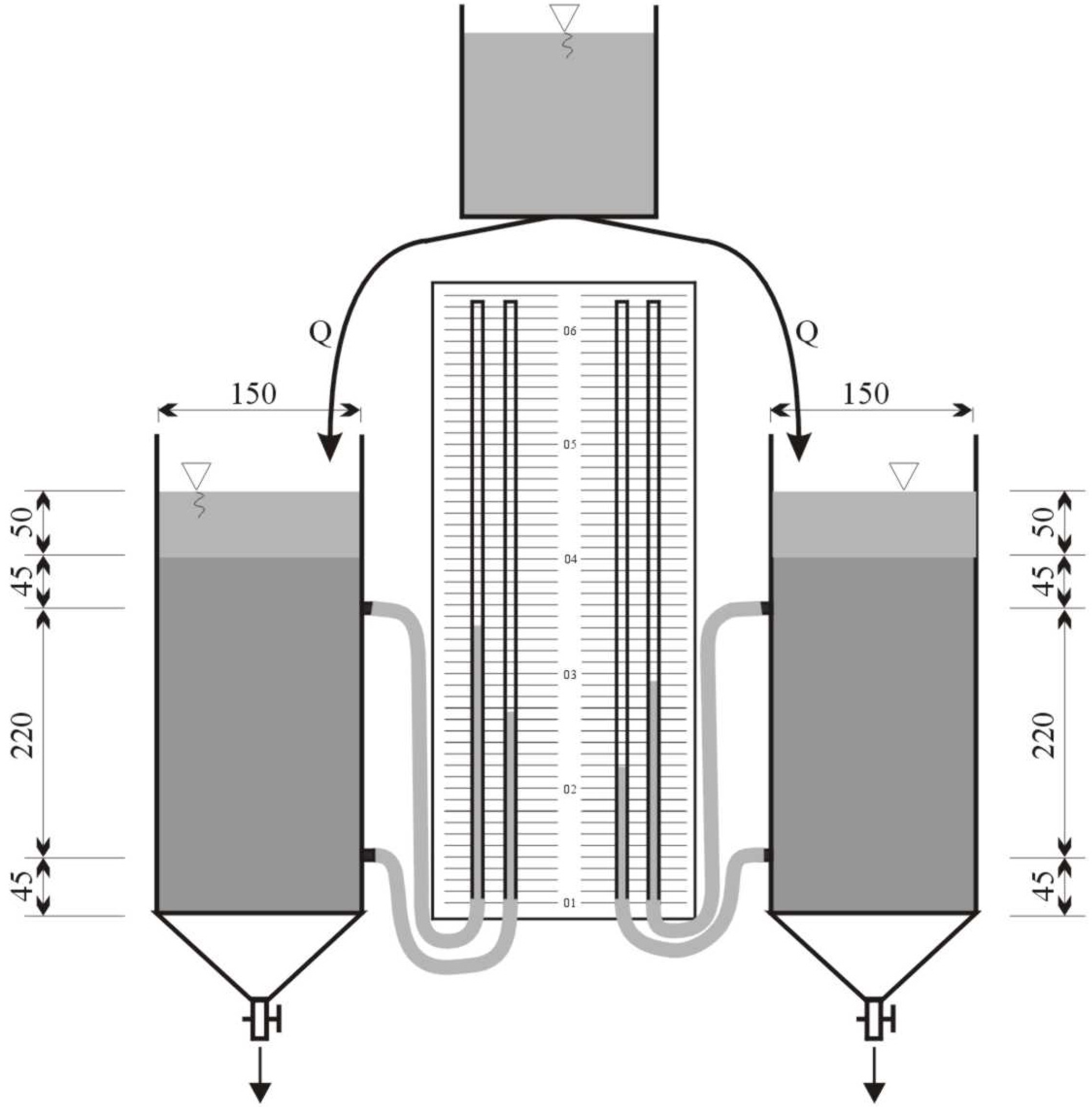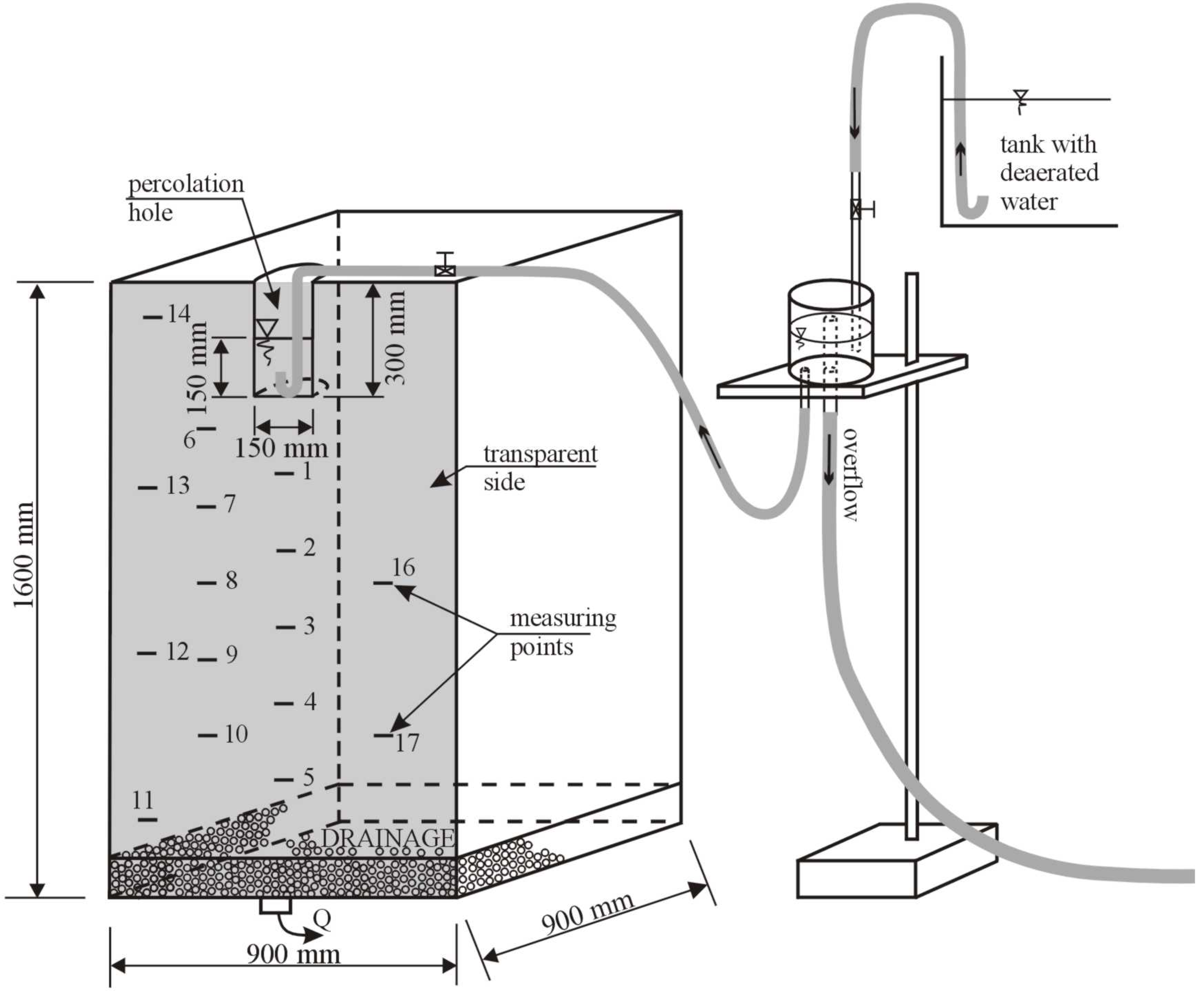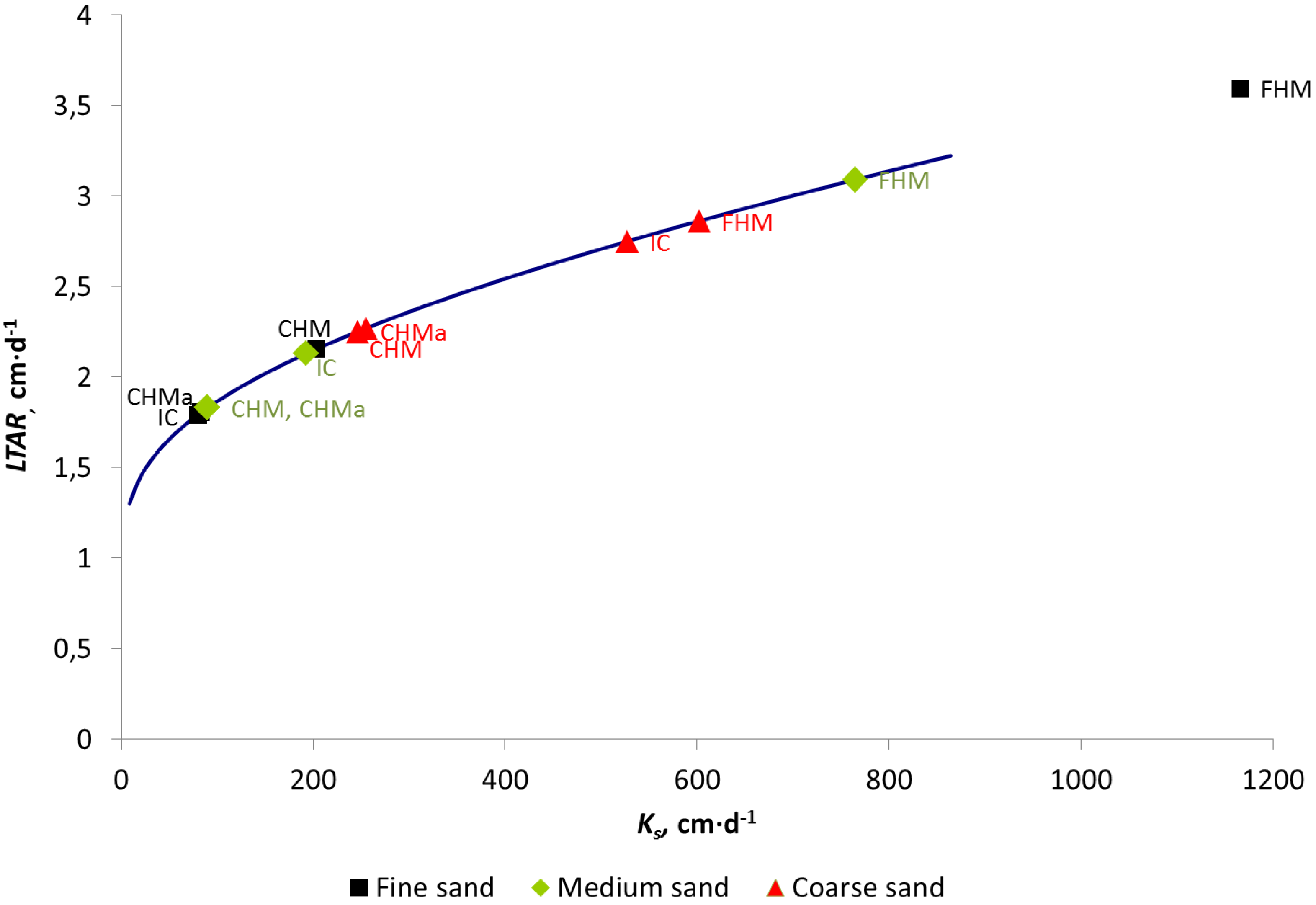Hydraulic Conductivity Estimation Test Impact on Long-Term Acceptance Rate and Soil Absorption System Design
Abstract
:1. Introduction
- LATR–long term acceptance rate, gal·ft−2·d−1, the utilization range between 0.32 and 0.80 gal·ft−2·d−1 (1.3 and 3.2 cm·d−1);
- Ks–hydraulic conductivity, ft·min−1.
- utilizing information about grain size distribution only, e.g., USBR (The United States Bureau of Reclamation) or Seelheim formula,
- demanding more information about the soil porosity or specific surface area, etc. as per the modified version of Hazen, the Krüger or Kozeny—Carman formula.
2. Experimental Procedures
2.1. Characteristic of Investigated Soils
| Soil type | Soil texture | Soil grain diameter | Bulk density | Porosity | ||||
|---|---|---|---|---|---|---|---|---|
| Percentage | ||||||||
| Gravel | Sand | Silt | Clay | d10 | d20 | P | n | |
| % | mm | g·cm−3 | % | |||||
| fine sand | 0.1 | 99 | 0.9 | - | 0.08 | 0.14 | 1.6 | 39 |
| medium sand | 0.5 | 98 | 1.5 | - | 0.14 | 0.20 | 1.8 | 32 |
| coarse sand | 15 | 85 | - | - | 0.27 | 0.30 | 1.85 | 30 |
2.2. Laboratory Measurements in Infiltration Column

- Ks–hydraulic conductivity, m·s−1;
- A–cross-section area of infiltration column, m2;
- Δhl–differenced in piezometer heights (head loss), m;
- L–length of the sample, m;
- V–seepage velocity, m·s−1;
- Q–discharge of flow, m3·s−1;
- I–hydraulic gradient;
- Ks–hydraulic conductivity, m·d−1;
- d10–effective grain size, mm;
- n–porosity, %.
- Ks–hydraulic conductivity, cm·s−1;
- d20–effective grain size, mm.
2.3. Scale Effect-Free Laboratory Method Conducted in Controlled Conditions
2.3.1. Research Set-Up Description

2.3.2. Calculations of Hydraulic Conductivity
- H0–initially water level in the hole, m;
- H1–final water level in the hole, m;
- r–radius of the hole, m;
- t–water falling time, s.
- Ks–hydraulic conductivity, m·s−1;
- Q–quantity water needed to hold a constant water level at H, m3·s−1;
- H–constant water level in the hole, m.
- a = 1–compacted clays;
- a = 4–unstructured fine-textured soils;
- a = 12–most structured soils from clays to loam and unstructured medium and fine sand and sandy loam;
- a = 36–coarse and gravelly sands.
3. Results and Discussion
Laboratory Measurements
| Soil type | Method | Mean value of K10 | N number of measurements | LTAR * | Percentage variation comparing to IC |
|---|---|---|---|---|---|
| (m·d−1) | - | (cm·d−1) | % | ||
| fine sand | IC | 0.80 ± 0.01 | 85 | 1.79 | |
| FHM | 11.66 ± 0.11 | 45 | 3.60 | 101% | |
| CHM | 2.03 ± 0.03 | 47 | 2.15 | 20% | |
| CHM a = 4 | 0.83 ± 0.01 | 47 | 1.80 | 1% | |
| Hazen | 5.9 | - | 2.85 | 59% | |
| USBR | 3.4 | - | 2.44 | 36% | |
| medium sand | IC | 1.93 ± 0.12 | 25 | 2.13 | |
| FHM | 7.65 ± 0.57 | 104 | 3.09 | 45% | |
| CHM | 0.90 ± 0.03 | 31 | 1.83 | −14% | |
| CHM a = 36 | 0.90 ± 0.03 | 31 | 1.83 | −14% | |
| Hazen | 12.5 | - | 3.70 | 73% | |
| USBR | 7.7 | - | 3.10 | 45% | |
| coarse sand | IC | 5.27 ± 0.1 | 102 | 2.75 | |
| FHM | 6.02 ± 0.39 | 147 | 2.86 | 4% | |
| CHM | 2.46 ± 0.08 | 295 | 2.25 | −18% | |
| CHM a = 36 | 2.55 ± 0.09 | 295 | 2.13 | −23% | |
| Hazen | 40.8 | - | 6.57 | 139% | |
| USBR | 19.5 | - | 4.47 | 62% |
- hk–capillary rise in m H2O;
- ψ–matrix potential m H2O.

4. Conclusions
- the differences in long-term acceptance rate values were about one magnitude smaller than differences in the hydraulic coeffcient (Figure 3), which is related to plotted function line slope;
- the research on medium and coarse sand showed that a similar result for hydraulic conductivity to that obtained from infiltration columns, which can be obtained using constant head tests; for the same types of soil the impact of difference between column measurements and constant water head test (CHM) measurement mean values on long-term acceptance rate value were relatively small–up to 14%–18%;
- studies conducted in fine sand confirmed a good convergence of hydraulic conductivity, using the infiltration column with constant head tests when the value of hydraulic conductivity is calculated with regard to capillary rise-the best agreements were given by the method of constant head measurement for the calculation of hydraulic conductivity, using the Philip equation for a parameter of 4;
- In the authors’ opinion the CHM tests measurements are acceptable for small systems (e.g., one family household). This test gives some overestimation, however it can be treated as a security factor preventing clogging risk. For calculating LTAR for low permeable soils (fine sand) the authors of this paper suggest using the CHM-a test where the unsaturated flow of water (common in small grain and pore diameter soils) can be determined thanks to a capillary rise determined by the test. For large surface area systems other, more precise methods or tests should be used to determine K in the field, e.g., infiltrometers;
- the cost of SAS designed based on CHM in comparison to designed based on real hydraulic conductivity value is higher up to 7%–9% of total on-site wastewater plant cost only;
- the result of hydraulic conductivity obtained in the falling head test can be overestimated due to the higher value of hydraulic gradient than unity assumed in development of the calculation formulae;
- the authors of this paper suggest using CHM-a especially for low permeable soils (e.g., fine sand) where the unsaturated flow of water occurs with regard to capillary rise so as to calculate hydraulic load as a LTAR.
Acknowledgments
Author Contributions
Conflicts of Interest
References
- Laak, R. Subsurface Soil System. In Wastewater Engineering Design for Unsewered Areas; Technomic Publishing Company: Lancaster, PA, USA, 1986. [Google Scholar]
- Amoozegar, A. Report No.316, Impact of Wastewater Quality on the Long-Term Acceptance Rate of Soils for On-Site Wastewater Disposal Systems; WRRI Project No. 70140; Water Resources Research Institute of the University of North Karolina, North Carolina State University: Raleigh, NC, USA, July 1998. [Google Scholar]
- Beal, C.D.; Gardner, E.A.; Kirchhof, G.; Menzies, N.W. Long-term flow rates and biomat zone hydrology in soil columns receiving septic tank effluent. Water Res. 2006, 40, 2327–2338. [Google Scholar]
- Radcliffe, D.E.; West, L.T. Spreadsheet for converting saturated hydraulic conductivity to long-term acceptance rate for on-ste wastewater systems. Soil Surv. Horiz. 2009, 50, 20–24. [Google Scholar]
- Pedescoll, A.; Uggetti, E.; Llorens, E.; Granés, F.; García, D.; García, J. Practical method based on saturated hydraulic conductivity used to assess clogging in subsurface flow constructed wetlands. Ecol. Eng. 2009, 35, 1216–1224. [Google Scholar]
- Scott Purdy; Vector Engineering Inc.; Joel Peters; Vector Chile Ltda. Comparison of Hydraulic Conductivity Test Methods for Landfill Clay Liners. In Proceedings of the Beacon Conference “Sanitary Landfills for Latin America”, Buenos Aires, Argentina, 8–10 March 2004.
- Sobieraj, J.A.; Elsendbeer, H.; Vartessy, R.A. Pedotransfer functions for estimating saturated hydraulic conductivity: Implications for modeling storm flow generation. J. Hydrol. 2001, 251, 202–220. [Google Scholar]
- Islam, N.; Wallander, W.W.; Mitchell, J.P.; Wicks, S.; Howitt, R.E. Performance evaluation of methods to the estimation of soil hydraulic parameters and their suitability in a hydrologic model. Geoderma 2006, 134, 135–151. [Google Scholar]
- Ghanbarian-Alavijeh, B.; Liaghat, A.M.; Sohrabi, S. Estimating saturated hydraulic conductivity from soil physical properties using neural networks model. World Acad. Sci. Eng. Technol. 2010, 4, 108–113. [Google Scholar]
- Slichter, C.S. Theoretical Investigations of the Motion of Ground Waters; 19th Annual Report, Part II; U.S. Geological Survey: Lei Sidui, VA, USA, 1899. [Google Scholar]
- Aronovici, V.S. The mechanical analysis as an index of subsoil permeability. Soil Sci. Soc. Am. J. 1947, 11, 137–141. [Google Scholar]
- Oosterbaan, R.J.; Nijland, H.J. Determining the saturated hydraulic conductivity. In Drainage Principles and ApplicationsILRI Publication 16, 2nd ed.; Ritzema, H.P., Ed.; ILRI Publication: Wageningen, the Netherlands, 1994. [Google Scholar]
- De Ridder, N.A.; Wit, K.E. A comparative study on the hydraulic conductivity of unconsolidated sediments. J. Hydrol. 1965, 3, 180–206. [Google Scholar]
- Odong, J. Evaluation of empirical formulae for determination of hydraulic conductivity based on grain-size analysis. Available online: http://www.engineerspress.com/pdf/IJAE/2013-01/a1%20_IJAE-133101_.pdf (accessed on 18 September 2014).
- Vuković, M.; Soro, A. Determination of Hydraulic Conductivity of Porous Media from Grain-size Composition; Water Resources Publications: Littleton, CO, USA, 1992; p. 83. [Google Scholar]
- Spychalski, M.; Kaźmierowski, C.; Kaczmarek, Z. The possibilities of indirect filtration coefficient assessment in soil. Polski Towarzystwo Geologiczne Oddział w Poznaniu 2004, Tom XIII, 48–56. (In Polish) [Google Scholar]
- Bouma, J. Unsaturated flow during soil treatment of septic tank effluent. J. Environ. Eng. 1975, 101, 967–983. [Google Scholar]
- Kropf, F.W.; Laak, R.; Healy, K.A. Equilibrium operation of subsurface absorption systems. J. Water Pollut. 1977, 49, 2007–2016. [Google Scholar]
- Beach, D.; McCray, J.; Lowe, K.; Siegrist, R. Temporal changes in hydraulic conductivity of sand porous media biofilters during wastewater infiltration due to biomat formation. J. Hydrol. 2005, 311, 230–243. [Google Scholar]
- Lange, O.K. Basic Hydrogeology (Osnovi Gidrogeologii); Moskovskii Gosudarstvenii Univerzitet: Moscow, Russia, 1958. (In Russian) [Google Scholar]
- Amoozegar, A. Comparison of saturated hydraulic conductivity and percolation rate: Implication for designing septic system. In proceedings of Symposium on the Site Characterization and Design of On-Site Septic Systems, New Orleans, LA, USA, 16–17 January 1997.
- Bagarello, V.; Giordano, G. Comparation of procedures to estimate steady flow rate in field measurement of saturated hydraulic conductivity by the Guelph Permeameter method. J. Agric. Eng. Res. 1999, 74, 63–71. [Google Scholar]
- Hayashi, M.; Quinton, W.L. A Constant-head well permeameter method for measuring field-saturated hydraulic conductivity above impermeable layer. Can. J. Soil Sci. 2004, 84, 255–264. [Google Scholar]
- Bronders, J. Field and Laboratory Measurements to Determine Hydraulic Conductivity; Faculty of Applied Science Laboratory of Hydrology, Free University Brussels: Brussels, Belgium, 1991. [Google Scholar]
- Elrick, D.E.; Reynolds, W.D.; Tan, K.A. Hydraulic conductivity measurements in the unsaturated zone using improved well analyses. Ground Water Monit. Remediat. 1989, 9, 184–193. [Google Scholar]
- Pedescoll, A.; Samo, R.; Romero, E.; Puigagut, J.; Garcia, J. Reliability, repeatability and accuracy of the falling head method for hydraulic conductivity measurements under laboratory conditions. Ecol. Eng. 2011, 37, 754–757. [Google Scholar] [CrossRef]
- Nieć, J. Comparison of hydraulic conductivity determination methods for wastewater drainage. Seria Melior. Inż. Środ. 2005, 26, 293–304. (In Polish) [Google Scholar]
- Spychała, M.; Nieć, J. Impact of septic tank sludge on filter permeability. Environ. Prot. Eng. 2013, 39, 77–89. [Google Scholar]
- Spychała, M.; Nieć, J.; Pawlak, M. Preliminary study on filamentous particle distribution in septic tank effluent and their impact on filter cake development. Environ. Technol. 2013, 34, 2829–2837. [Google Scholar]
© 2014 by the authors; licensee MDPI, Basel, Switzerland. This article is an open access article distributed under the terms and conditions of the Creative Commons Attribution license (http://creativecommons.org/licenses/by/3.0/).
Share and Cite
Nieć, J.; Spychała, M. Hydraulic Conductivity Estimation Test Impact on Long-Term Acceptance Rate and Soil Absorption System Design. Water 2014, 6, 2808-2820. https://doi.org/10.3390/w6092808
Nieć J, Spychała M. Hydraulic Conductivity Estimation Test Impact on Long-Term Acceptance Rate and Soil Absorption System Design. Water. 2014; 6(9):2808-2820. https://doi.org/10.3390/w6092808
Chicago/Turabian StyleNieć, Jakub, and Marcin Spychała. 2014. "Hydraulic Conductivity Estimation Test Impact on Long-Term Acceptance Rate and Soil Absorption System Design" Water 6, no. 9: 2808-2820. https://doi.org/10.3390/w6092808




